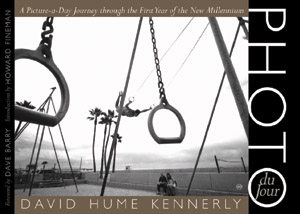
November 2002 In
my Advanced Photojournalism class at The University of Texas at Austin,
the first exercise I assigned the students was a lesson in "Seeing
the Picture." We used the multimedia story by photographer Sam
Abell from the June issue of The Digital Journalist as a resource. Their
assignment was to use only one camera and one lens, a wide angle, to
shoot some pictures. This lesson emphasized making choices in composition
and capturing the moment. I wish that we had a copy of David Hume Kennerly's
Photo
Du Jour available for the class back in September because that exercise
is exactly what Kennerly assigned himself for an entire year.
Kennerly is a major force in photojournalism. He is known as a master
of access. Many people admire this Pulitzer Prize winner's journalistic skills and know-how, but few would consider him an artist. Yet, in 1999 he began to make plans to undertake an ambitious project that would require him to document his world as it was moving into a new century and make a commitment to take at least one picture every day for 365 days. To make these photographs different from the thousands of images he would produce on assignments throughout the year, he decided that the pictures he would shoot for the project would all be taken with one a camera. He chose a big format Mamiya 6x7, with only one lens, a wide angle approximating the field of view of a 21mm lens on a 35mm. The entire project was captured with black and white film. Even for David this was a daunting proposal. To make things even more difficult, halfway through his project he was bedridden for over a week following knee surgery. He actually took pictures from his bed in Santa Monica. He photographed from planes as he shuttled around the world. Children and friends became his subjects for the project in addition to documenting the political campaigns of 2000. The result is a striking book, which appeared in bookstores last month. A huge exhibition of photographs from the book opened at the Smithsonian Museum in Washington D.C. in conjunction with The Center for American History at the University of Texas. By forcing himself to use only one camera and one lens, David's work suddenly became far more disciplined photographically. In fact he has become an artist. We are proud to present David's 365-day project, accompanied by his
commentary through streaming video in this month's issue. |
||
Enter Photo Du Jour - by David Kennerly
| Video Presentation Camera: Dirck Halstead To view these interview clips, you must have |

|
|
Write a Letter
to the Editor |
